
Question Number 110299 by Lekhraj last updated on 28/Aug/20

Answered by Her_Majesty last updated on 28/Aug/20

$$\mathrm{5}{x}+\mathrm{5}{y}=\mathrm{2}{xy} \\ $$$$\Rightarrow\:\mathrm{5}\mid{xy}\:\Rightarrow\:\mathrm{5}\mid{x}\vee\mathrm{5}\mid{y} \\ $$$${let}\:{x}=\mathrm{5}{k} \\ $$$$\mathrm{25}{k}+\mathrm{5}{y}=\mathrm{10}{ky} \\ $$$${y}=\frac{\mathrm{5}{k}}{\mathrm{2}{k}−\mathrm{1}} \\ $$$${k}=\mathrm{1}\:\Rightarrow\:{y}=\mathrm{5}\wedge{x}=\mathrm{5}\:{but}\:{x}\neq{y} \\ $$$${k}=\mathrm{3}\:\Rightarrow\:{y}=\mathrm{3}\wedge{x}=\mathrm{15}\:\Rightarrow\:\sqrt{{x}+{y}}=\mathrm{3}\sqrt{\mathrm{2}} \\ $$$${only}\:{solution}\:{because}\:\frac{\mathrm{5}{k}}{\mathrm{2}{k}−\mathrm{1}}>\mathrm{2}\forall{k}>\mathrm{0} \\ $$$${of}\:{course}\:{x}=\mathrm{3}\wedge{y}=\mathrm{15}\:{is}\:{the}\:\mathrm{2}^{{nd}} \:{possibility} \\ $$$${but}\:{it}\:{also}\:{leads}\:{to}\:\sqrt{{x}+{y}}=\mathrm{3}\sqrt{\mathrm{2}} \\ $$
Commented by Lekhraj last updated on 28/Aug/20

$$\mathrm{Thanks} \\ $$
Commented by udaythool last updated on 28/Aug/20
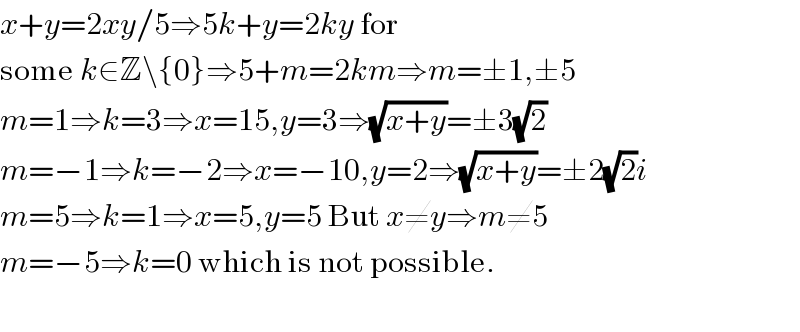
$${x}+{y}=\mathrm{2}{xy}/\mathrm{5}\Rightarrow\mathrm{5}{k}+{y}=\mathrm{2}{ky}\:\mathrm{for} \\ $$$$\mathrm{some}\:{k}\in\mathbb{Z}\backslash\left\{\mathrm{0}\right\}\Rightarrow\mathrm{5}+{m}=\mathrm{2}{km}\Rightarrow{m}=\pm\mathrm{1},\pm\mathrm{5} \\ $$$${m}=\mathrm{1}\Rightarrow{k}=\mathrm{3}\Rightarrow{x}=\mathrm{15},{y}=\mathrm{3}\Rightarrow\sqrt{{x}+{y}}=\pm\mathrm{3}\sqrt{\mathrm{2}} \\ $$$${m}=−\mathrm{1}\Rightarrow{k}=−\mathrm{2}\Rightarrow{x}=−\mathrm{10},{y}=\mathrm{2}\Rightarrow\sqrt{{x}+{y}}=\pm\mathrm{2}\sqrt{\mathrm{2}}{i} \\ $$$${m}=\mathrm{5}\Rightarrow{k}=\mathrm{1}\Rightarrow{x}=\mathrm{5},{y}=\mathrm{5}\:\mathrm{But}\:{x}\neq{y}\Rightarrow{m}\neq\mathrm{5} \\ $$$${m}=−\mathrm{5}\Rightarrow{k}=\mathrm{0}\:\mathrm{which}\:\mathrm{is}\:\mathrm{not}\:\mathrm{possible}. \\ $$$$ \\ $$
Commented by Her_Majesty last updated on 28/Aug/20

$${the}\:{question}\:{says}\:``{distinct}\:{positive}\:{integers}'' \\ $$$${so}\:{as}\:{I}\:{stated},\:{there}'{s}\:{only}\:{one}\:{solution} \\ $$
Commented by Rasheed.Sindhi last updated on 28/Aug/20
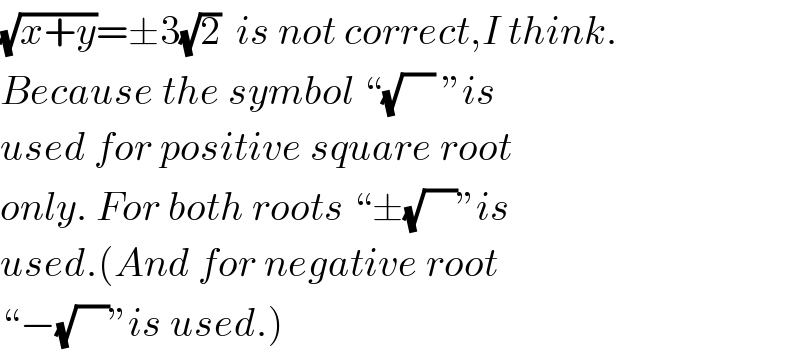
$$\sqrt{{x}+{y}}=\pm\mathrm{3}\sqrt{\mathrm{2}}\:\:{is}\:{not}\:{correct},{I}\:{think}. \\ $$$${Because}\:{the}\:{symbol}\:``\sqrt{\:\:\:\:}\:''{is} \\ $$$${used}\:{for}\:{positive}\:{square}\:{root} \\ $$$${only}.\:{For}\:{both}\:{roots}\:``\pm\sqrt{\:\:\:\:}''{is} \\ $$$${used}.\left({And}\:{for}\:{negative}\:{root}\:\right. \\ $$$$\left.``−\sqrt{\:\:\:\:}''{is}\:{used}.\right) \\ $$
Commented by Her_Majesty last updated on 28/Aug/20
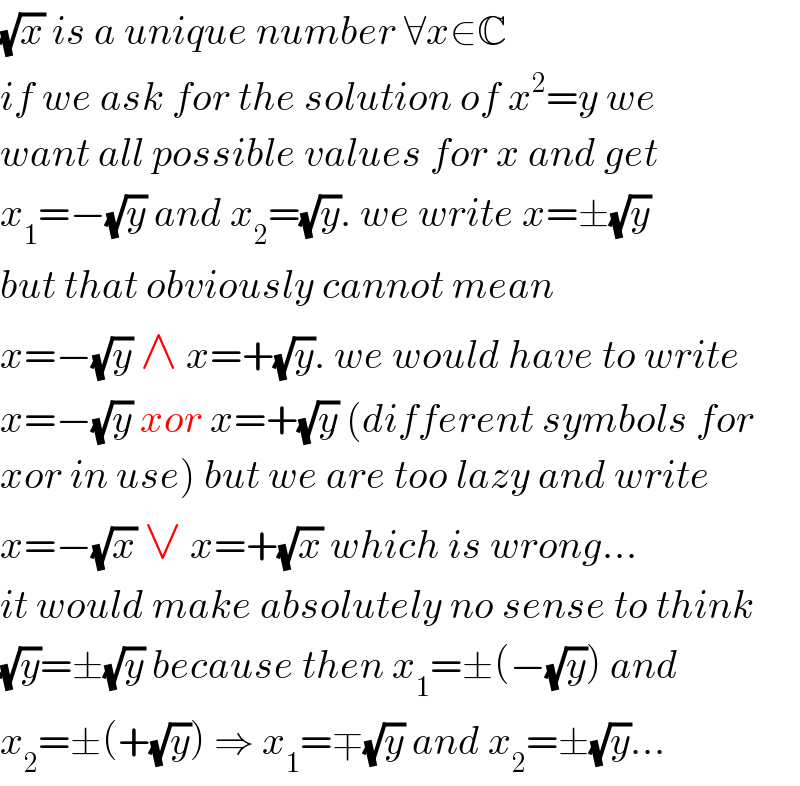
$$\sqrt{{x}}\:{is}\:{a}\:{unique}\:{number}\:\forall{x}\in\mathbb{C} \\ $$$${if}\:{we}\:{ask}\:{for}\:{the}\:{solution}\:{of}\:{x}^{\mathrm{2}} ={y}\:{we} \\ $$$${want}\:{all}\:{possible}\:{values}\:{for}\:{x}\:{and}\:{get} \\ $$$${x}_{\mathrm{1}} =−\sqrt{{y}}\:{and}\:{x}_{\mathrm{2}} =\sqrt{{y}}.\:{we}\:{write}\:{x}=\pm\sqrt{{y}} \\ $$$${but}\:{that}\:{obviously}\:{cannot}\:{mean} \\ $$$${x}=−\sqrt{{y}}\:\wedge\:{x}=+\sqrt{{y}}.\:{we}\:{would}\:{have}\:{to}\:{write} \\ $$$${x}=−\sqrt{{y}}\:{xor}\:{x}=+\sqrt{{y}}\:\left({different}\:{symbols}\:{for}\right. \\ $$$$\left.{xor}\:{in}\:{use}\right)\:{but}\:{we}\:{are}\:{too}\:{lazy}\:{and}\:{write} \\ $$$${x}=−\sqrt{{x}}\:\vee\:{x}=+\sqrt{{x}}\:{which}\:{is}\:{wrong}... \\ $$$${it}\:{would}\:{make}\:{absolutely}\:{no}\:{sense}\:{to}\:{think} \\ $$$$\sqrt{{y}}=\pm\sqrt{{y}}\:{because}\:{then}\:{x}_{\mathrm{1}} =\pm\left(−\sqrt{{y}}\right)\:{and} \\ $$$${x}_{\mathrm{2}} =\pm\left(+\sqrt{{y}}\right)\:\Rightarrow\:{x}_{\mathrm{1}} =\mp\sqrt{{y}}\:{and}\:{x}_{\mathrm{2}} =\pm\sqrt{{y}}... \\ $$
Commented by udaythool last updated on 28/Aug/20

$$\mathrm{Oh}! \\ $$$$\mathrm{Yes},\:\mathrm{I}\:\mathrm{haven}'\mathrm{t}\:\mathrm{noticed}... \\ $$
Answered by Rasheed.Sindhi last updated on 28/Aug/20
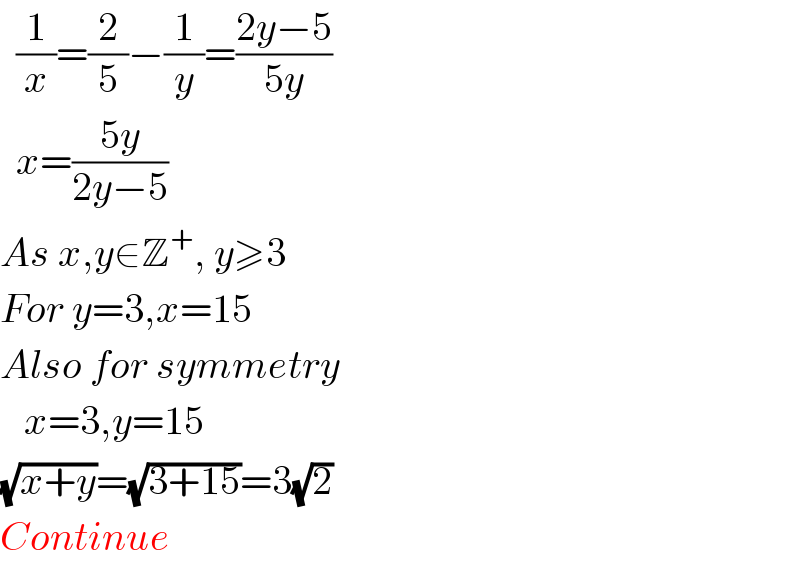
$$\:\:\frac{\mathrm{1}}{{x}}=\frac{\mathrm{2}}{\mathrm{5}}−\frac{\mathrm{1}}{{y}}=\frac{\mathrm{2}{y}−\mathrm{5}}{\mathrm{5}{y}} \\ $$$$\:\:{x}=\frac{\mathrm{5}{y}}{\mathrm{2}{y}−\mathrm{5}} \\ $$$${As}\:{x},{y}\in\mathbb{Z}^{+} ,\:{y}\geqslant\mathrm{3} \\ $$$${For}\:{y}=\mathrm{3},{x}=\mathrm{15} \\ $$$${Also}\:{for}\:{symmetry} \\ $$$$\:\:\:{x}=\mathrm{3},{y}=\mathrm{15} \\ $$$$\sqrt{{x}+{y}}=\sqrt{\mathrm{3}+\mathrm{15}}=\mathrm{3}\sqrt{\mathrm{2}} \\ $$$${Continue} \\ $$
Commented by Lekhraj last updated on 28/Aug/20

$$\mathrm{Thanks} \\ $$
Answered by 1549442205PVT last updated on 29/Aug/20

$$\frac{\mathrm{1}}{\mathrm{x}}+\frac{\mathrm{1}}{\mathrm{y}}=\frac{\mathrm{2}}{\mathrm{5}}\Leftrightarrow\frac{\mathrm{x}+\mathrm{y}}{\mathrm{xy}}=\frac{\mathrm{2}}{\mathrm{5}}\Leftrightarrow\mathrm{2xy}=\mathrm{5}\left(\mathrm{x}+\mathrm{y}\right) \\ $$$$\Leftrightarrow\mathrm{4xy}−\mathrm{10}\left(\mathrm{x}+\mathrm{y}\right)+\mathrm{25}=\mathrm{25} \\ $$$$\Leftrightarrow\left(\mathrm{2x}−\mathrm{5}\right)\left(\mathrm{2y}−\mathrm{5}\right)=\mathrm{25}\:\:\left(\mathrm{1}\right)\Rightarrow\left(\mathrm{2x}−\mathrm{5}\:\right)\mathrm{is} \\ $$$$\mathrm{an}\:\mathrm{odd}\:\mathrm{divisor}\:\mathrm{of}\:\mathrm{25} \\ $$$$\Rightarrow\mathrm{2x}−\mathrm{5}\in\left\{\mathrm{1},−\mathrm{1},\mathrm{5},−\mathrm{5},−\mathrm{25},\mathrm{25}\right\} \\ $$$$\left.\mathrm{i}\right)\mathrm{2x}−\mathrm{5}=\mathrm{1}\Rightarrow\mathrm{x}=\mathrm{3}\:.\mathrm{Replace}\:\mathrm{into}\:\left(\mathrm{1}\right)\:\mathrm{we} \\ $$$$\mathrm{get}\:\mathrm{y}=\mathrm{15} \\ $$$$\left.\mathrm{ii}\right)\mathrm{2x}−\mathrm{5}=−\mathrm{1}\Rightarrow\mathrm{x}=\mathrm{2}.\mathrm{Replace}\:\mathrm{into} \\ $$$$\left(\mathrm{1}\right)\mathrm{we}\:\mathrm{get}\:\mathrm{y}=−\mathrm{10}\:\notin\mathbb{Z}^{+} \Rightarrow\mathrm{rejected} \\ $$$$\left.\mathrm{iii}\right)\mathrm{2x}−\mathrm{5}=\mathrm{5}\Rightarrow\mathrm{x}=\mathrm{5}.\mathrm{Replace}\:\mathrm{into}\:\left(\mathrm{1}\right) \\ $$$$\mathrm{we}\:\mathrm{get}\:\mathrm{y}=\mathrm{5} \\ $$$$\left.\mathrm{iv}\right)\mathrm{2x}−\mathrm{5}=−\mathrm{25}\Rightarrow\mathrm{x}=−\mathrm{10}\Rightarrow\mathrm{rejected} \\ $$$$\left.\mathrm{v}\right)\mathrm{2x}−\mathrm{5}=\mathrm{25}\Rightarrow\mathrm{x}=\mathrm{15}\Rightarrow\mathrm{y}=\mathrm{3} \\ $$$$\mathrm{Combinating}\:\mathrm{all}\:\mathrm{above}\:\mathrm{cases}\:\mathrm{we}\:\mathrm{get} \\ $$$$\left(\mathrm{x},\mathrm{y}\right)\in\left\{\left(\mathrm{3},\mathrm{15}\right),\left(\mathrm{5},\mathrm{5}\right),\left(\mathrm{15},\mathrm{3}\right)\right\} \\ $$$$\Rightarrow\sqrt{\boldsymbol{\mathrm{x}}+\boldsymbol{\mathrm{y}}}\:\in\left\{\mathrm{3}\sqrt{\mathrm{2}}\:,\sqrt{\mathrm{10}}\right\} \\ $$
Commented by Her_Majesty last updated on 29/Aug/20

$${saying}\:{it}\:{again},\:{we}'{re}\:{searching}\:{for}\:{distinct} \\ $$$${integers}\:\Rightarrow\:{x}\neq{y} \\ $$
Commented by Rasheed.Sindhi last updated on 29/Aug/20
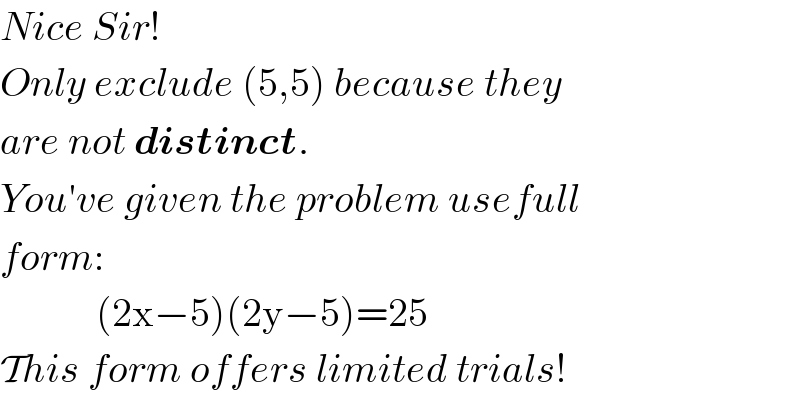
$${Nice}\:{Sir}! \\ $$$${Only}\:{exclude}\:\left(\mathrm{5},\mathrm{5}\right)\:{because}\:{they} \\ $$$${are}\:{not}\:\boldsymbol{{distinct}}. \\ $$$${You}'{ve}\:{given}\:{the}\:{problem}\:{usefull} \\ $$$${form}: \\ $$$$\:\:\:\:\:\:\:\:\:\:\:\:\left(\mathrm{2x}−\mathrm{5}\right)\left(\mathrm{2y}−\mathrm{5}\right)=\mathrm{25} \\ $$$$\mathcal{T}{his}\:{form}\:{offers}\:{limited}\:{trials}! \\ $$
Commented by 1549442205PVT last updated on 30/Aug/20

$$\mathrm{Thank}\:\mathrm{Sir}.\mathrm{I}\:\mathrm{don}'\mathrm{t}\:\mathrm{note}\:\mathrm{that} \\ $$$$\mathrm{hypothesis}\:. \\ $$
